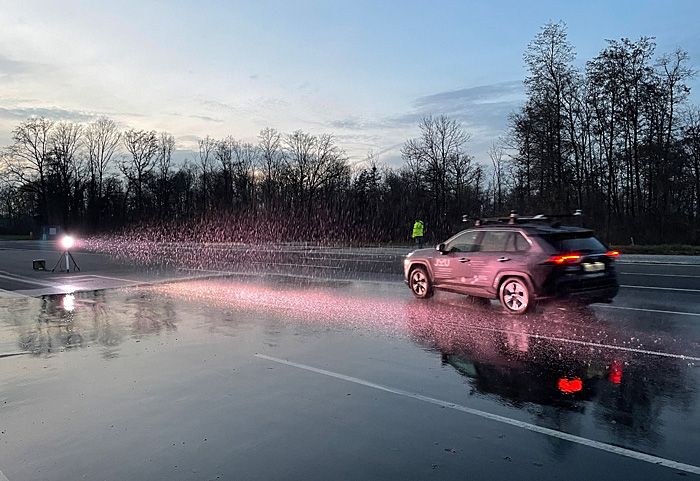Automated Driving in Wet and Rainy Conditions
Lane markings must be clearly detectable, especially in difficult conditions. This is true for automated vehicles, in particular. In a recent test that put lane markings through their paces, a high-performance marking system with SWARCO SOLIDPLUS reflective glass beads made a compelling case.
SWARCO Road Marking Systems is working with researchers of the Johannes Kepler University Linz to assess the machine detectability of lane markings in different conditions. Using a camera-based system and LiDAR sensors, the research team conducted tests in wet and rainy conditions. A first look at the data collected has already revealed that the structured marking with premium reflective glass beads that was tested is much easier to detect.

Wet conditions and poor visibility: In such situations, high-performance marking systems with SWARCO SOLIDPLUS reflective glass beads show their strength. This has been backed by initial data collected from the JKU vehicle in tests conducted at the Digitrans test center for automated driving in St. Valentin, Austria.
Photo: SWARCO Road Marking Systems
Bad weather often makes driving a challenge – drivers have to cope with limited visibility and take longer braking distances into account. In such situations, maximum concentration and adapted driving behaviours can make all the difference. Therefore, clearly detectable road markings are of tremendous help when roads are wet due to rain and visibility is poor. Especially in conditions like these, lane markings provide crucial orientation – both to humans and machines.
Impact on Machine Vision
For SWARCO Road Marking Systems, this raises the following question regarding automated driving and autonomous vehicles: How well are automated vehicles able to recognize lane markings in adverse weather conditions? For this purpose, the world’s largest systems provider for road markings conducted tests together with researchers from the Chair for Sustainable Transport Logistics 4.0 at the Johannes Kepler University Linz.
For the test series, the researchers used the Digitrans test center for automated driving in St. Valentin, Austria. Expanding on a test series carried out in good weather, they examined the detectability of standard and high-performance marking systems.
Marking Systems Tested
The following systems were tested on the test track: a high-performance marking system consisting of a structured cold-plastic marking with SWARCO SOLIDPLUS premium reflective glass beads, and the standard system, which is a plain cold-spray-plastic marking with standard glass beads. The different markings’ detectability was tested on dry and wet roads, as well as in rainy conditions of varying intensity.
The rainy conditions were created by the new outdoor sprinkler system, which can produce rain that simulates real rainfall at the push of a button. In the section with artificially reproduced rain conditions, the JKU test vehicle drove on several lanes of the test track in both directions. The test vehicle was equipped with a commercially available camera-based driver assistance system. In addition, data was collected using three LiDAR (Light Detection and Ranging) sensors.
Higher Probabilities
The driver assistance system used the sensor data to calculate the detection probability for the markings on the test track. “Based on our first look at the data, the high-performance markings with SWARCO SOLIDPLUS can be clearly detected in wet road conditions. Compared to the standard markings, the probability that the camera-based system would detect these markings is up to 30 percent higher,” says Friedrich Wiesinger, Team Leader in the Center of Competence, SWARCO Road Marking Systems’ globally connected research department, summarizing the first findings.
And these are just first impressions gained by the team of SWARCO Road Marking Systems and the Johannes Kepler University Linz, which is currently working on the detailed analysis of the data they collected. The scientific articles that will come out of their work are sure to reveal further exciting findings on how wet conditions and rain affect the machine detectability of lane markings.